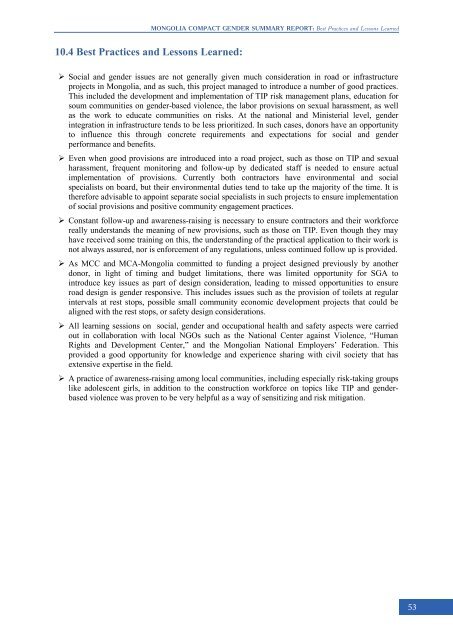Ulaanbaatar 2013
Ulaanbaatar 2013
Ulaanbaatar 2013
Create successful ePaper yourself
Turn your PDF publications into a flip-book with our unique Google optimized e-Paper software.
Mongolia Compact Gender Summary Report: Best Practices And Lessons Learned10.4 Best Practices and Lessons Learned:‣ Social and gender issues are not generally given much consideration in road or infrastructureprojects in Mongolia, and as such, this project managed to introduce a number of good practices.This included the development and implementation of TIP risk management plans, education forsoum communities on gender-based violence, the labor provisions on sexual harassment, as wellas the work to educate communities on risks. At the national and Ministerial level, genderintegration in infrastructure tends to be less prioritized. In such cases, donors have an opportunityto influence this through concrete requirements and expectations for social and genderperformance and benefits.‣ Even when good provisions are introduced into a road project, such as those on TIP and sexualharassment, frequent monitoring and follow-up by dedicated staff is needed to ensure actualimplementation of provisions. Currently both contractors have environmental and socialspecialists on board, but their environmental duties tend to take up the majority of the time. It istherefore advisable to appoint separate social specialists in such projects to ensure implementationof social provisions and positive community engagement practices.‣ Constant follow-up and awareness-raising is necessary to ensure contractors and their workforcereally understands the meaning of new provisions, such as those on TIP. Even though they mayhave received some training on this, the understanding of the practical application to their work isnot always assured, nor is enforcement of any regulations, unless continued follow up is provided.‣ As MCC and MCA-Mongolia committed to funding a project designed previously by anotherdonor, in light of timing and budget limitations, there was limited opportunity for SGA tointroduce key issues as part of design consideration, leading to missed opportunities to ensureroad design is gender responsive. This includes issues such as the provision of toilets at regularintervals at rest stops, possible small community economic development projects that could bealigned with the rest stops, or safety design considerations.‣ All learning sessions on social, gender and occupational health and safety aspects were carriedout in collaboration with local NGOs such as the National Center against Violence, “HumanRights and Development Center,” and the Mongolian National Employers‟ Federation. Thisprovided a good opportunity for knowledge and experience sharing with civil society that hasextensive expertise in the field.‣ A practice of awareness-raising among local communities, including especially risk-taking groupslike adolescent girls, in addition to the construction workforce on topics like TIP and genderbasedviolence was proven to be very helpful as a way of sensitizing and risk mitigation.Page 53 of 8053


